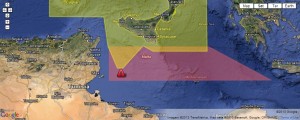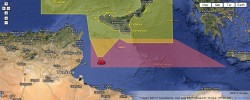
 After the recent tragedies in the Southern Mediterranean Sea (SouthMed), when several improvised vessels – transporting illegal immigrants to the coasts of Italy and Malta – sank, resulting in the death of several hundred immigrants, the issue of migration flows crossing the SouthMed has resurfaced to the international stage. Italian Prime Minister Letta offered an unprecented, and not well received, official apology for the loss of lives at sea, promising more surveillance in the area and, most importantly, to bring the matter to the forthcoming October meeting of the European Council.
After the recent tragedies in the Southern Mediterranean Sea (SouthMed), when several improvised vessels – transporting illegal immigrants to the coasts of Italy and Malta – sank, resulting in the death of several hundred immigrants, the issue of migration flows crossing the SouthMed has resurfaced to the international stage. Italian Prime Minister Letta offered an unprecented, and not well received, official apology for the loss of lives at sea, promising more surveillance in the area and, most importantly, to bring the matter to the forthcoming October meeting of the European Council.
The situation was briefly discussed, with the promise of an improved commitment of the EU, especially through its border control agency, FRONTEX, in supporting the Italian struggle in the SouthMed.[1] Unfortunately – although one may say luckily for those States which don’t wish to be entangled in expensive border control operations – the issue was overshadowed by the NSA scandal, with the well-known protests by several European leaders.
Returning to the matter at hand, Italy has promptly launched Operazione Mare Nostrum[2], deploying 6 additional ships and supporting aircrafts for enhanced surveillance operations in the SouthMed, in particular:
– The San Marco, San Giorgio-class amphibious assault ship (7790 tons), command ship;
– 2 Frigates Maestrale-class (3100 tons);
– 2 Patrol ships Comandanti-class (1500 tons);
– 1 Transport Ship Gorgona-class (630 tons)
– For airborne surveillance, 1 Long-range Maritime Patrol Aircraft Breguet Atlantic, 1 Predator, 1 Patrol Aircraft P-180, 2 EH101 helicopters, 4 Agusta-Bell 212 helicopters and 1 Search and Rescue helicopter HH-139 SAR.[3]
At the same time, reports of a possible agreement with the Finnish Coast Guard surfaced, with Finland sending technical and equipment support to Italy. Moreover, FRONTEX is reportedly going to send financial help to Italy, for its ongoing operations and future endeavors. In practical terms, it appears that the European response to the issue is, at least in the short-term, fairly adequate. It is also apparent that a definitive solution to the crisis will require a more substantial commitment to the area and to the stability of the States on the Southern end of the Mediterranean.
Although it is clear that the EU should undertake a more substantial role in a long-term solution, it is also clear that many within the EU would be more than happy to commit to conciliatory statements and visits (the last visit to Lampedusa by the President of the Commission Barroso and the Italian Prime Minister Letta was welcomed by protests) rather than action.[4] What many commentators, especially those who accuse Italy of negligence and complicity in such tragedies, forget is that Italy’s borders facing illegal immigration are completely maritime, thus increasing the costs and risks for surveillance and assistance. Moreover, illegal immigration activities carried at sea entail a completely different set of technical, juridical and even physical problems that are unknown to land borders. The current practice of the individuals transporting illegal immigrants is that of reaching the Search and Rescue Areas (SAR) of Italy and Malta,[5] then disabling their boats and sending a distress call to the Italian authorities, which are then legally bound to locate and rescue them. Once the Italian Navy or Coast Guard reaches the distressed vessel, it is either towed or its passengers taken on board by Italian ships and carried to Lampedusa. There the illegal immigrants are screened and given the possibility to apply for asylum or to be repatriated. As an obvious consequence, the current crisis has completely overwhelmed the processing centers in the small island, thus sparking protests by both Lampedusa’s residents and the “interned” immigrants. For these reasons, Italy has been in “crisis mode” for more than a decade in its SouthMed area, and it is not likely to overcome this issue on its own. It must be underlined that only the incredible efforts of the Italian Coast Guard, Navy and Guardia di Finanza[6] have made it so that these tragedies at sea are exceptional, rather than the norm, saving more than 30000 illegal immigrants since January 2013.[7]
It is apparent that a solution to the current situation needs to pass through an improvement in the internal situation of the States of origin of the migrants, or at least in the ports where they board to try to reach Europe.[8] In previous maritime-borne immigration crises (such as those stemming from the Balkans in the 90s), only an improvement in the countries of provenience eventually blocked the immigration flows. In practical terms though, the effort for stabilizing Libya and improving the feeble governmental structures in Tunisia has to come from the EU. Firstly because of its calling to put together European interests in the protection of democracy, human rights and the rule of law, and second because the EU is the sole entity with both the political and budgetary power to face the matter head-on. Nevertheless, one of the most renowned issues in EU foreign policy is the need for unanimity decisions by all its Member States, and today – as in the foreseeable future – consensus on a substantial commitment to the security and safety situation of the SouthMed appears unlikely. This does not mean that all avenues for the EU are closed. Despite the need for a unanimous decision on major shifts in foreign policy, there are a series of institutions and bodies which can help in practice – even better than a European Council deliberation – on the matter. The EU Commission Development and Cooperation Directorate General (DG DEVCO) has the power to initiate development projects with third States, and the European External Action Service (EEAS) has the capabilities and connections to analyze and establish the policy priorities in the SouthMed. Moreover, the vice-President of the Commission (the second in ranking in the institution) also happens to be the Head of the EEAS (as the High Representative for Foreign Affairs and Security Policy), thus a coordinated effort is indeed possible.[9] Lastly, various integrated surveillance systems (e.g. SeaBILLA)[10] are under study, with the objective of putting together the European Union Member States maritime control systems and authorities for an enhanced cooperation in the area of sea-monitoring. While FRONTEX is going to financially support the Italian Navy and Coast Guard and the possible agreement with Finland will bring more vessels and personnel to the area, much more is needed on the Southern end of the Mediterranean Sea.
It is in the nature of an institution such as the EU to work on consensus, and such consensus is often forged on the wave of public support driven by exceptional events, such as the tragedies in the SouthMed. Nevertheless, it is also in the nature of such institutions to respond to public pressure with conciliatory remarks and provisional policies, avoiding politically complicated high-level negotiations. Whether the EU leadership will put its supportive statements into practice remains to be seen, but it is apparent that the time of temporary responses to endemic crises is over.
Matteo Quattrocchi holds a LL.M. from Georgetown Law as well as a Master’s Degree in European and International Law from Luiss in Rome, Italy. He is currently a Junior Researcher at the European Institute for Asian Studies, after having worked in the NGO and private sector and taught in Rome and Washington, D.C. He is specialized in International and National Security Law and Policies, EU-Asia Relations and Maritime Security Law and Policies.
[1] European Council Conclusions, 25 October 2013, find at http://www.consilium.europa.eu/uedocs/cms_data/docs/pressdata/en/ec/139197.pdf
[2] As a side note, many Human Rights organizations have protested the name of the operation, claiming it has a colonialist sound to it, as Mare Nostrum was the name the Romans gave to the Mediterranean, literally meaning “our sea”, a term also often used during the 1910s expansion of the Italian Reign. The author believes that any further comment on such “protests” is merely a waste of bytes (although at least not of ink and paper).
[3] Gianandrea Gaiani, Operazione Mare Nostrum, Analis Difesa, 22 October 2013,find at http://www.analisidifesa.it/2013/10/operazione-mare-nostrum/ and the Italian Navy website, http://www.marina.difesa.it/EN/thefleet/Pagine/default.aspx
[4] EU leaders rebuff calls for action on Europe’s migration crisis, Reuters, 25 October 2013. Find at http://www.reuters.com/article/2013/10/25/us-eu-migrants-idUSBRE99O0NB20131025
[5] There is a long-standing diplomatic row between Italy and Malta, as in theory most of the ships that end up being towed to Lampedusa are rescued within the Maltese SAR. Italy has requested Malta to limit its SAR to its actual capabilities, but Malta has staunchly refused to this day. Moreover, Malta applies UNCLOS to the letter, allowing migrant vessels freedom of passage in its controlled waters. When a distress call is sent, Maltese authorities often refer to the Italian Coast Guard (even within their SAR), claiming that they don’t have the technical capability to rescue the vessels or that they are closer to Lampedusa. When a distressed vessel is rescued within the Maltese SAR, Italy requests to make port in Malta, but such requests are generally refused, claiming that Italian structures are better suited to sheltering distressed vessels and their passengers.
[6] This is Italy’s Customs and Border Police, which has also jurisdiction over tax frauds (hence the name Finance Guard).
[7] Italian Coast Guard General Command, News Release, 9 October 2013, find at http://www.guardiacostiera.it/dalcomandogenerale/documents/notizia_20131009084556.pdf
[8] Hugh Williamson and Judith Sunderland, Shipwrecked. No Easy Fix For Europe’s Asylum Policy, Foreign Affairs, 24 October 2013. Find at http://www.foreignaffairs.com/articles/140223/hugh-williamson-and-judith-sunderland/shipwrecked
[9] The EU has created a Task Force for the SouthMed in 2011, pairing the EEAS, the Commission, the European Investment Bank and the European Bank for Reconstruction and Development. The current state of the SouthMed does not speak up for the results of this task force. For more information please see HR Catherine Ashton sets up Task Force
for the Southern Mediterranean, EEAS, 7 June 2011 at http://europa.eu/rapid/press-release_IP-11-688_en.htm
[10] For more information please visit http://www.seabilla.eu/cms/seabilla

